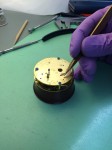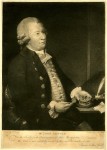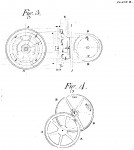 On March 3rd of this year, the Newport Historical Society (NHS) in Rhode Island announced via Twitter, Facebook and Instagram that staff members were on a secret mission in the UK. A follow-up image taken at the Pitt Rivers Museum was posted the next day, and then a third photo showed a gloved hand working on what looks like a timepiece.
On March 3rd of this year, the Newport Historical Society (NHS) in Rhode Island announced via Twitter, Facebook and Instagram that staff members were on a secret mission in the UK. A follow-up image taken at the Pitt Rivers Museum was posted the next day, and then a third photo showed a gloved hand working on what looks like a timepiece.
The secret mission, it turns out, was to send Ingrid Peters to the Royal Observatory, Royal Museums Greenwich, to have their experts examine a pocket watch from the NHS collection. The Royal Observatory’s curator of Horology Rory McEvoy confirmed that the watch was not just a watch, but rather fourth in a series of five precision marine chronometers made by watchmaker John Arnold to calculate longitude. It was made around 1772. The third of the series is the only other one in the series known to have survived, and it’s in the British Museum.
 John Arnold was born in 1736 in Bodmin, Cornwall, the son of watchmaker and nephew of a gunsmith. He worked for his uncle for a while, ultimately following in his father’s footsteps and becoming a highly skilled and innovative watchmaker. In 1764, just two years after opening a shop of his own in London, Arnold secured permission to present to King George III and his court the smallest repeating watch in the world. The half-quarter repeating watch cylinder escapement watch was mounted in a ring. The king and courtiers were impressed, and Arnold quickly became the watchmaker to the rich and aristocratic.
John Arnold was born in 1736 in Bodmin, Cornwall, the son of watchmaker and nephew of a gunsmith. He worked for his uncle for a while, ultimately following in his father’s footsteps and becoming a highly skilled and innovative watchmaker. In 1764, just two years after opening a shop of his own in London, Arnold secured permission to present to King George III and his court the smallest repeating watch in the world. The half-quarter repeating watch cylinder escapement watch was mounted in a ring. The king and courtiers were impressed, and Arnold quickly became the watchmaker to the rich and aristocratic.
His ingenuity was put to the test in a problem that had obsessed clockmakers for decades: create a timepiece that would allow British sailors to calculate longitude while on board ship. Clockmaker John Harrison invented the marine timepiece which made it possible for the first time to calculate longitude at sea in 1759. His invention, which looked like an oversized pocket watch, took him six years to build, too long for his timepiece to be in compliance with the 1714 Longitude Act‘s requirement that construction of the device be practical as well as accurate. The whole point, after all, was for every ship in the Royal Navy to have one, so production had to streamlined.
 In 1767, the Board of Longitude published a detailed illustrated description of Harrison’s clock, The Principles of Mr. Harrison’s Timekeeper, and spread it around to inventors in the hope that one of them might figure out a way to build a faster, better mousetrap, as it were. Astronomer Royal Nevil Maskelyne gave Arnold a copy hot off the presses. He went his own way, creating a different device he presented to the Board in 1771. It was a clock in a mahogany box, and three of them were put to the test by Captains James Cook and Furneaux during Cook’s second voyage to the southern Pacific in 1772-1775.
In 1767, the Board of Longitude published a detailed illustrated description of Harrison’s clock, The Principles of Mr. Harrison’s Timekeeper, and spread it around to inventors in the hope that one of them might figure out a way to build a faster, better mousetrap, as it were. Astronomer Royal Nevil Maskelyne gave Arnold a copy hot off the presses. He went his own way, creating a different device he presented to the Board in 1771. It was a clock in a mahogany box, and three of them were put to the test by Captains James Cook and Furneaux during Cook’s second voyage to the southern Pacific in 1772-1775.
Arnold’s were not very effective — only one of them survived the voyage in some semblance of working order — so he turned to pocket marine timekeepers instead. They worked. Captain Constantine Phipps, 2nd Baron Mulgrave, took one with him to the North Pole in 1773 and it performed like a champ. The Newport Historical Society’s chronometer — a term coined by John Arnold for a precision timekeeper and still in use today — is one of these.
This watch, produced in the early 1770s while one of Arnold’s see-saw escapement timekeepers was away on sea trials features a pivoted detent escapement; others had designed such mechanisms, but Arnold’s was a technological improvement.
It has an impeccable provenance, too.
The watch was acquired by Peleg Clarke in 1792. Clarke was a descendant of one of Newport’s first English settlers and wealthy merchant of the American colonial period who likely bought the watch from Arnold during a trip to London. He was an eyewitness to the Boston Tea Party and recorded his impressions in a letter now also in the society’s collections. The watch was passed down in the Clarke family for over 200 years, as a pocket watch, until it was donated to the society in 1997.
Arnold & Son, the company John Arnold founded in the 1787 with his clockmaker son, John Roger Arnold, is still in business today, and still makes marine chronometers, now in wrist watch form rather than pocket watch.